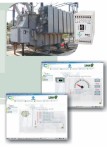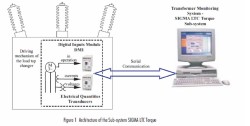SIGMA – LTC Torque On-line Monitoring Sub-system Load Tap Changer Motor Torque
The Load Tap Changer (LTC) is one of the principal sources of failures in power transformers, arising from the existence of moving parts that conduct and interrupt high currents while exposed to high electrical potentials.
As well as thermal failures (see SIGMA LTC Diff Sub-system), some of the common failure modes in LTCs are of a mechanical nature, such as in the motor driven mechanism or in the tap changer itself, leading indirectly to serious transformer failures.
The energy necessary for the mechanical working of the LTC is supplied by a motor driven mechanism, depending on the force used to overcome every stage of the commutation process, will exercise a larger or smaller torque. The torque has a “signature” or “finger print” which, under normal operational conditions, is repeated in an approximately equal manner as each tap change is carried out. Alterations in the mechanical functioning of the tap changer will provoke changes in this signature, allowing mechanical failures to be detected, even in their incipient phases.
As the torque, developed by a electric motor, is proportional to its mechanical power, and hence is proportional to the electrical power consumed, the torque can be indirectly monitored by measuring the consumption of the motor. The objective is to detect alterations in the torque during the life of the LTC, and not to affect the exact measurements of the absolute value of the torque.
SIGMA LTC Torque Monitoring Sub-system is a software module which, together with the Data Acquisition Module DM1 and a transducer to measure the electrical power magnitudes, carries out the on-line monitoring of the torque developed by the LTC motor. During the various stages of commutation the torque signature is monitored, as well as, the total commutation time, facilitating the detection of mechanical failures in the tap changer before they reach a degree of severity that will precipitate into greater problems.
SIGMA LTC Torque permits remote access to on-line measurements and to historical data, stored in data banks. Remote access is carried out over the Intranet or Internet network, using a standard Internet browser. The system can also send alert messages by e-mail or text messaging to mobile phones (SMS) when the system diagnoses an abnormal condition, freeing operators from the need for permanent supervision of the system.
SIGMA Monitoring Systems and Sub-systems architecture
The SIGMA monitoring system is based on a Decentralized and Modular architecture, in which Intelligent Electronic Devices (IEDs) are used as sensors (data sources) interconnected to the SIGMA monitoring system over a communication network. Frequently these IEDs are pieces of equipment that are essentially used in transformers in protective, supervisory and control functions, supplying information to the monitoring system through one of their serial ports. This makes centralizing units at the body of the transformer unnecessary; this architecture eliminates the necessity for specific sensors, resulting in a significant reduction in the cost of the system. This is the case with SIGMA Ageing Sub-system, as shown in the diagram.
SIGMA monitoring software, obeying the same philosophy as the Treetech IEDs, is composed of independent and scalable modules called Sub-systems, allowing the user to build their own monitoring system, according to their needs. As such, the Treetech modular systems allow the monitoring of small-scale transformers, eliminating the financial barriers that previously limited the application of monitoring systems to large-scale equipment only.



